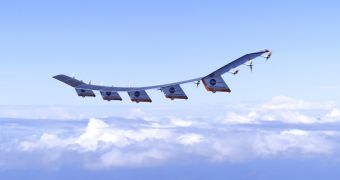The Pentagon has decided: out with the Northrup Grumman project and in with Manassas Vulture high-altitude unmanned aerial vehicle. The Vulture will be used by the Pentagon as a surveillance and communications aircraft, which can be repositioned on an area of interest and fly high enough to capture a wide view image of the ground beneath it, something which cannot be done with the satellites currently positioned on the Earth's orbit.
Once completed, the Vulture will have a 152.4 meters wingspan, will be able to lift itself to heights of 27,432 meters above ground and should stay into the Earth's atmosphere up to five years without requiring any maintenance or fueling. Additionally, the Vulture must carry a 454.5 kilograms payload and generate at least 5 kilowatts of electric power in order to remain operational at all time.
"We want to completely change the paradigm of how we thing of aircraft. We would no longer define an aircraft by the launch, recover, maintain, launch cycle," says Vulture project manager Daniel Newman. Working along side with Manassa Aurora Flight Services will be traditional military aircraft developers Boeing and Lockheed Martin, which will manage the prototype developing stages.
Aurora Flight Sciences is expected to unveil its Odysseus unmanned aircraft design today, a prototype composed of three segments 50 meters in size, able to launch independently that link up with each other in middle flight. Odysseus is allegedly powered by a large array of solar panels positioned on the aircraft's wings, which will have the ability to pivot so that the maximum sunlight collection area is maximized.
On the other hand, the two aircraft manufacturer giants Boeing and Lockheed Martin are yet to propose a prototype, however they may also consider a design involving multiple segments launching independently, linking up, disengage, land and then launch again, during which time the main component of the aircraft remains into the air. Designers are also considering the use of fuel cells as an alternative for the least efficient solar panel, in which case multiple refueling components will be critical.

 14 DAY TRIAL //
14 DAY TRIAL //